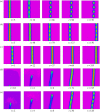Stabilizing a homoclinic stripe
- PMID: 30420550
- PMCID: PMC6232602
- DOI: 10.1098/rsta.2018.0110
Stabilizing a homoclinic stripe
Abstract
For a large class of reaction-diffusion systems with large diffusivity ratio, it is well known that a two-dimensional stripe (whose cross-section is a one-dimensional homoclinic spike) is unstable and breaks up into spots. Here, we study two effects that can stabilize such a homoclinic stripe. First, we consider the addition of anisotropy to the model. For the Schnakenberg model, we show that (an infinite) stripe can be stabilized if the fast-diffusing variable (substrate) is sufficiently anisotropic. Two types of instability thresholds are derived: zigzag (or bending) and break-up instabilities. The instability boundaries subdivide parameter space into three distinct zones: stable stripe, unstable stripe due to bending and unstable due to break-up instability. Numerical experiments indicate that the break-up instability is supercritical leading to a 'spotted-stripe' solution. Finally, we perform a similar analysis for the Klausmeier model of vegetation patterns on a steep hill, and examine transition from spots to stripes.This article is part of the theme issue 'Dissipative structures in matter out of equilibrium: from chemistry, photonics and biology (part 2)'.
Keywords: pattern formation; reaction–diffusion systems; stability of patterns.
© 2018 The Author(s).
Conflict of interest statement
We declare we have no competing interests.
Figures




References
-
- Doelman A, van derPloeg H. 2002. Homoclinic stripe patterns. SIAM J. Appl. Dyn. Syst. 1, 65–104. (10.1137/S1111111101392831) - DOI
-
- Morgan DS, Kaper TJ. 2004. Axisymmetric ring solutions of the 2D Gray–Scott model and their destabilization into spots. Physica D 192, 33–62. (10.1016/j.physd.2003.12.012) - DOI
-
- Kolokolnikov T, Ward MJ, Wei J. 2006. Zigzag and breakup instabilities of stripes and rings in the two-dimensional Gray–Scott model. Stud. Appl. Math. 116, 35–95. (10.1111/j.1365-2966.2005.0333.x) - DOI
-
- Sewalt L, Doelman A. 2017. Spatially periodic multipulse patterns in a generalized Klausmeier–Gray–Scott model. SIAM J. Appl. Dyn. Syst. 16, 1113–1163. (10.1137/16M1078756) - DOI
LinkOut - more resources
Full Text Sources

